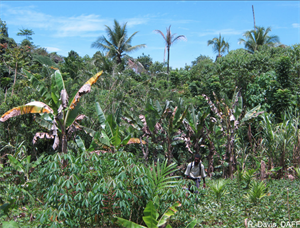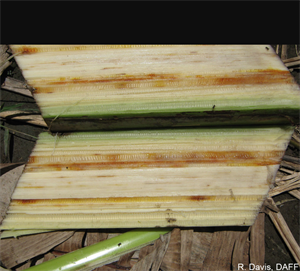Banana wilt-associated phytoplasma. The abbreviation is BWAP.
Pacific Pests, Pathogens, Weeds & Pesticides - Online edition
Pacific Pests, Pathogens, Weeds & Pesticides
Banana wilt phytoplasma (372)
There is no scientific name for the disease, the common name, Banana wilt-associated phytoplasma, BWAP, is used.
Phytoplasmas were first associated with banana wilt when plants with yellowing leaves were tested growing among coconuts showing signs of Bogia coconut syndrome in Madang Province, Papua New Guinea (see Fact Sheet no. 229). (Note, Bogia coconut syndrome is referred to as Cocos nucifera lethal yellowing phytoplasma in some publications.)
Molecular tests of the16S ribosomal protein gene (16Sr RNA) have shown that the same phytoplasma appears to be present in both banana and coconut (16SrIV-C) in the Madang area. Further, the phytoplasma is related to a coconut lethal yellowing phytoplasma recorded from Nigeria, associated with a disease known as Awka wilt. Later, in a taxonomic change, Atwa wilt phytoplasma was moved to the 16SrXXII-A group.
However, in other parts of Papua New Guinea (away from Madang) and in Solomon Islands where banana wilt-associated phytoplasma wilts occurs, other phytoplasmas have been identified: 16SrII, 16SrVIII and 16SrXXII-A in Papua New Guinea, and 16SrXXII-A and 16SrIV-A in Solomon Islands. Coconuts in the areas where they occur do not show disease associated with phytoplasma.
Several provinces of Papua New Guinea, and Maleai Island, just south of Shortland Islands, Solomon Islands. The latter is south of Bougainville, near to the border with Papua New Guinea.
Musa species, principally cooking bananas or plantains (ABB according to the international convention for naming banana types), and (for some phytoplasmas) coconuts.
A serious disease, invariably fatal. In 2012, isolated ABB cooking bananas from several provinces in Papua New Guinea were reported that were yellowing and dying (Photo 1). Internally, the stems show discontinuous black or brown streaks in the vascular tissues (Photo 2), and pockets of wet rot. Some diseased bananas occured where Bogia coconut syndrome was present, but for many the coconuts appeared healthy.
Later, in 2015, a severe wilt of cooking banana (ABB) was reported to be widespread on Maleai Island, Choiseul Province, Solomon Islands, close to the Autonomous region of Bougainville, Papua New Guinea. Plants showed yellowing and/or leaf death, and unfilled fruit bunches, with internal stem symptoms similar to those described in Papua New Guinea.
Tests for phytoplasmas were posivite wherever the yellowing plants were samplped. Although not proof of cause of disease, the fact that phytoplasmas were associated only with wilt symptoms was thought indicative of cause.
Spread of phytoplasmas occurs when sap-feeding insects feed on the phloem of infected plants. In the case of BWAP, the insect (or insects) which spreads the disease is not yet known. Because the phytoplasma in banana is identical to the phytoplasma in coconuts in Papua New Guinea, the same insect, or one closely related, is likely to spread the disease.
To date, in Papua New Guinea, interest has centred on Zophiuma pupillata (Hemiptera: Lophopidae), which breeds on coconuts and is common on that host and also betel nuts. It is less common on banana. Phytoplasmas are frequently detected in both adults and nymphs.
However, several other insects from different families are also common on coconuts and found to contain phytoplasmas; one of them is a species of Proustia, an insect that is known to spread phytoplasma diseases of coconut (India) and sugarcane (Southeast Asia).
The discovery of this disease is the cause of considerable concern in Papua New Guinea and Solomon Islands where banana is an important food crop. On Maleai Island, Solomon Islands, all plants of one variety appeared diseased. By contrast, in Papua New Guinea, the disease is widespread throughout the country, but the number of plants with symptoms in any locality is small. The concern in both countries is twofold: one, the disease will increase in severity; and, two, spread will occur to coconuts. In all areas, where bananas are infected by the disease, coconuts appear healthy, apart from the Madang area.
Look for bananas with yellowing, leaves that die slowly, with internal dark, discontinuous lines and pockets of rot. Confirmation of the phytoplasma is done using molecular methods.
BIOSECURITY
Internal quarantine containment is recommended in Solomon Islands. Many parts of the country has been surveyed in recent years without finding BWAP symptoms. The recommendation specifically suggests a ban on the movement of bananas from the Shortland Islands of which Maleai Island is a part.
It is important to alert biosecurity authorities if banana plants are found with wilted yellow leaves as descrtibed in this fact sheet.
CULTURAL CONTROL
Banana plants should be removed, cut up and buried as soon as symptoms are first seen; it is important not to leave suckers which will also be infected, even if not showing symptoms. Ideally, plants should be sprayed with insecticide before they are cut down to kill insects which may otherwise spread the disease (see below).
If insecticide is used, after 48 hours dig out the stool, including the main plants and all suckers. Chop the plants, including the corms, into small pieces. Burn or bury them.
CHEMICAL CONTROL
The choice of chemicals for killing insects on diseased plants, before removal from the soil, depends on whether they are grown for household use or for sale.
- Banana for home use: Use kerosene, aiming to spray the 'throat', the V-shaped area where the leaves meet and where insects hide.
- Commercial plantations: The following have been recommended for Pacific island countries: dimethoate (400 g/L), used at 75 ml/100L; diazinon (200 g/L), used at 1.5 ml/L; acephate (75% WP), used at 1.3 g/L. Note, in Australia, the use of dimethoate is restricted, and the use of the chemical remains under review. Diazinon use is also under review. Acephate does not have approval for use in the EU, and is under review in Australia.
- Synthetic pyrethroids are likely to be effective.
____________________
When using a pesticide, always wear protective clothing and follow the instructions on the product label, such as dosage, timing of application, and pre-harvest interval. Recommendations will vary with the crop and system of cultivation. Expert advice on the most appropriate pesticides to use should always be sought from local agricultural authorities.
AUTHOR Grahame Jackson
Information from Anne Vezina (2013) A new disease of banana? ProMusa. (http://www.promusa.org/blogpost229-A-new-disease-of-banana); and Davis et al. (2012) A new wilt disease of banana plants associated with phytoplasmas in Papua New Guinea (PNG) (2012). Australasian Plant Disease Notes 7:91-97. (https://www.researchgate.net/publication/257801469); and Pilotti et al. Putative vectors of a phytoplasma associated with coconut (Cocos nucifera) in Madang Province, Papua New Guinea. International Journal of Agriculture and Forestry 4:365-372. (http://article.sapub.org/10.5923.j.ijaf.20140405.04.html); Davis RI et al. (2012) A new wilt disease of banana plants assocviated with phytoplasmas in Papua New Guinea (PNG). Australasian Plant Disease Notes 12(7): 91-97. (doi: 10.1007/s13314-012-0056-8); and from Davis RI et al. (2015) First record of a wilt disease of banana associated with phytoplasma in Solomon Islands. Australasian Plant Disease Notes 10:14. (https://link.springer.com/article/10.1007/s13314-015-0163-4). Photos 1&2 Richard Davis, Northern Australia Quarantine Strategy, Department of Agriculture, Cairns, Australia.
Produced with support from the Australian Centre for International Agricultural Research under project HORT/2016/185: Responding to emerging pest and disease threats to horticulture in the Pacific islands, implemented by the University of Queensland and the Secretariat of the Pacific Community.





